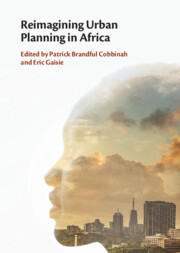Book contents
- Reimagining Urban Planning in Africa
- Reimagining Urban Planning in Africa
- Copyright page
- Contents
- Contributors
- Foreword
- Preface
- Acknowledgements
- Abbreviations
- Part I Understanding Sustainable Urban Planning in Africa
- Part II Case Studies on Urban Planning in African Countries
- Part III Sustainable Urban Planning in Africa
- 14 On the Need for Sustainable Digital Urban Infrastructure in Twenty-First-Century South African Cities
- 15 The South African Landownership Struggle
- 16 The 2030 Agenda, Climate Urbanism and Urban Planning in Zimbabwe
- 17 Urban Planning and Quality of Life of Urban Residents in Africa
- 18 Realising Rights in Complex Informal Settlements Contexts
- 19 Participatory Design Won’t Fix Unequal Southern African Cities
- 20 Enabling Smart Mobility in African Cities
- 21 On the Future of Urban Planning in Africa
- Index
- References
18 - Realising Rights in Complex Informal Settlements Contexts
The Case of Mukuru Informal Settlements, Nairobi
from Part III - Sustainable Urban Planning in Africa
Published online by Cambridge University Press: 07 December 2023
- Reimagining Urban Planning in Africa
- Reimagining Urban Planning in Africa
- Copyright page
- Contents
- Contributors
- Foreword
- Preface
- Acknowledgements
- Abbreviations
- Part I Understanding Sustainable Urban Planning in Africa
- Part II Case Studies on Urban Planning in African Countries
- Part III Sustainable Urban Planning in Africa
- 14 On the Need for Sustainable Digital Urban Infrastructure in Twenty-First-Century South African Cities
- 15 The South African Landownership Struggle
- 16 The 2030 Agenda, Climate Urbanism and Urban Planning in Zimbabwe
- 17 Urban Planning and Quality of Life of Urban Residents in Africa
- 18 Realising Rights in Complex Informal Settlements Contexts
- 19 Participatory Design Won’t Fix Unequal Southern African Cities
- 20 Enabling Smart Mobility in African Cities
- 21 On the Future of Urban Planning in Africa
- Index
- References
Summary
Spatial governance in Kenyan cities has been practised in a manner that is exclusionary and that denies certain groups access to resources and opportunities. In Nairobi, land tenure has been used to craft an exclusionary idea of urban citizenship. Eligibility to participate in spatial governance has been made conditional on having formally recognised interests in land. Marginalised groups have in turn deployed a range of measures to contest power and counter exclusion. They have resisted persistent attempts at their erasure from the cityscape by carrying out acts of transgression within a context now underwritten by a transformative constitutional framework. Within the Mukuru informal settlements, transgressive and legal strategies are toolboxes from which inhabitants draw a plethora of tools to confront exclusionary spatial governance practices. This chapter examines how, in using these strategies, the inhabitants deploy their democratic imaginations to test their understandings of urban citizenship and expand its realms. In doing this, the inhabitants reimagine urban planning in a form that is more inclusive and that attends to the realities within their spaces.
- Type
- Chapter
- Information
- Reimagining Urban Planning in Africa , pp. 325 - 344Publisher: Cambridge University PressPrint publication year: 2023



